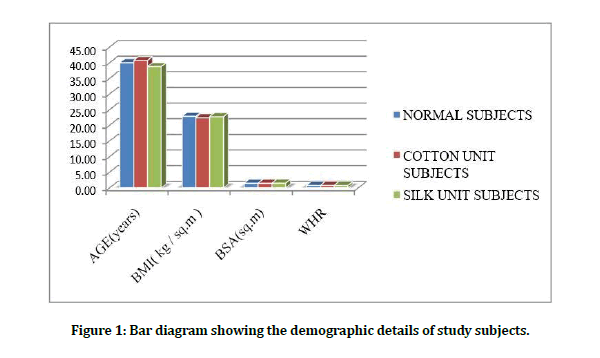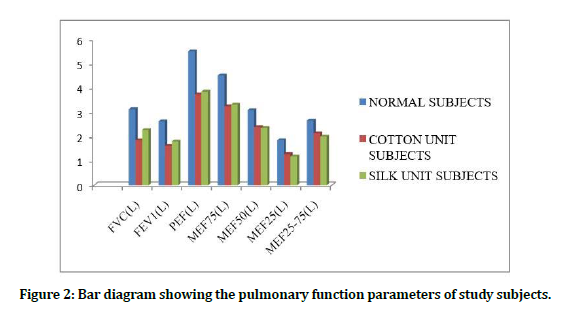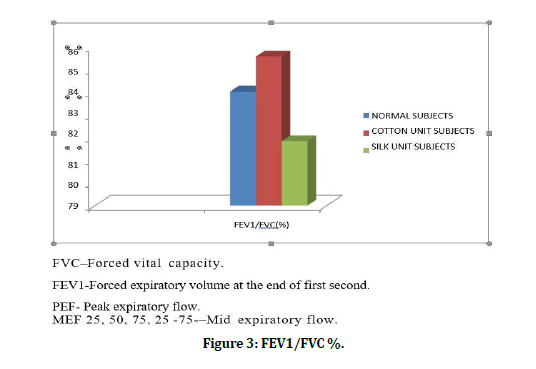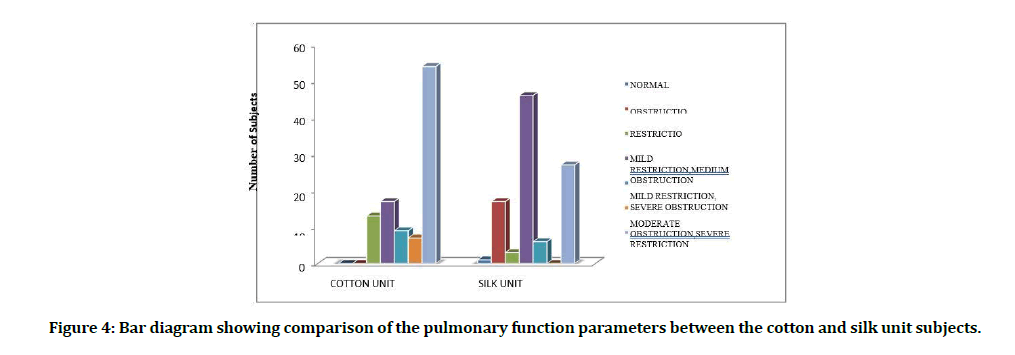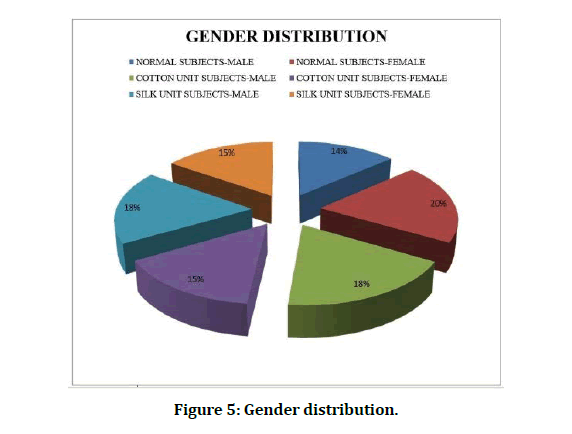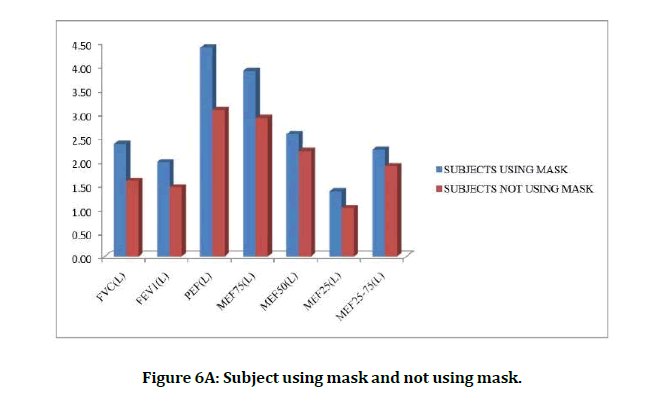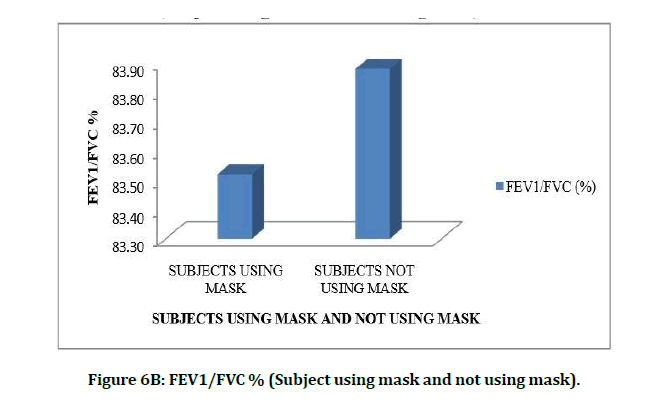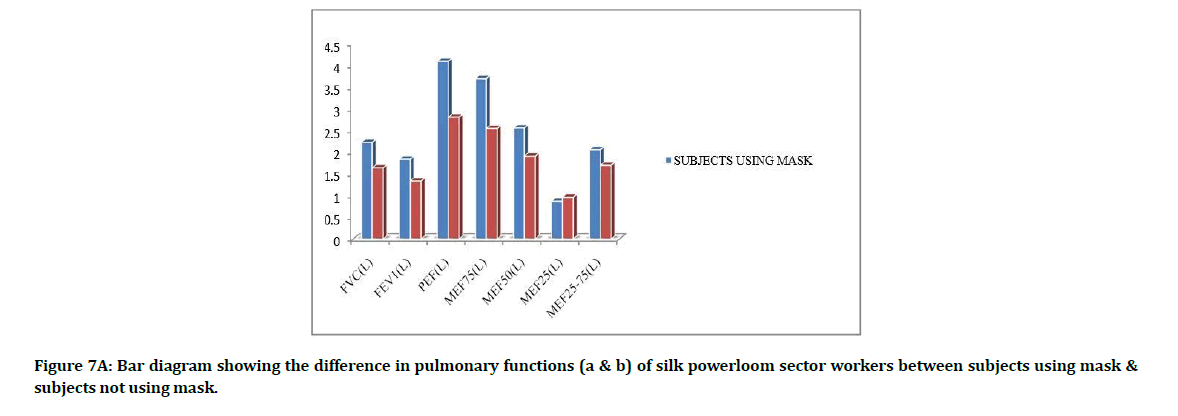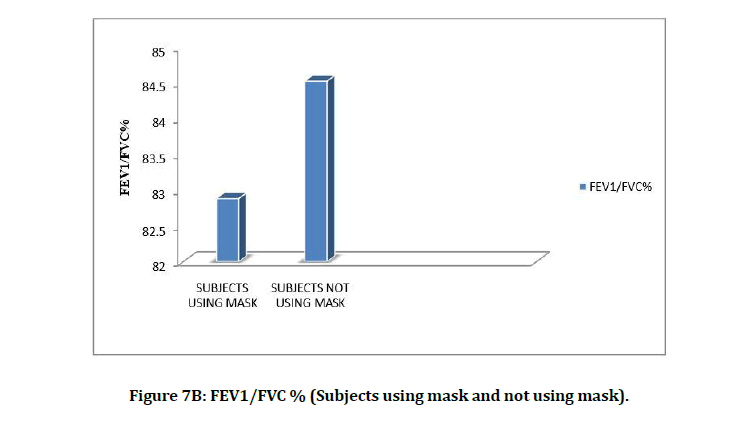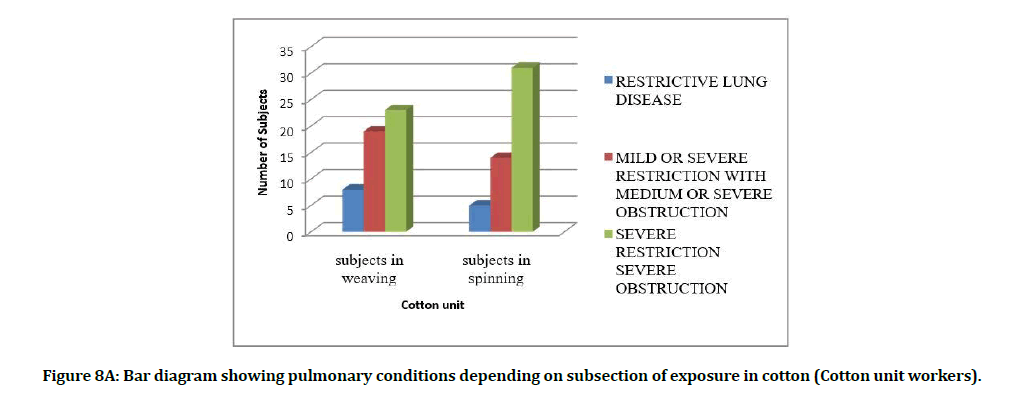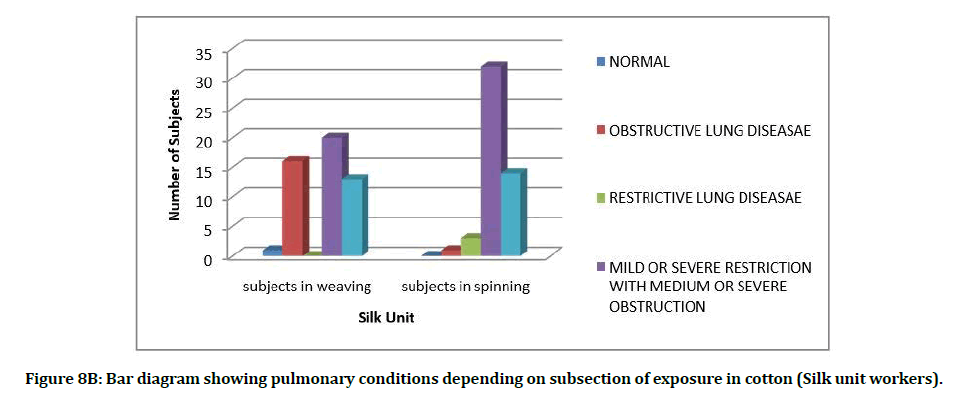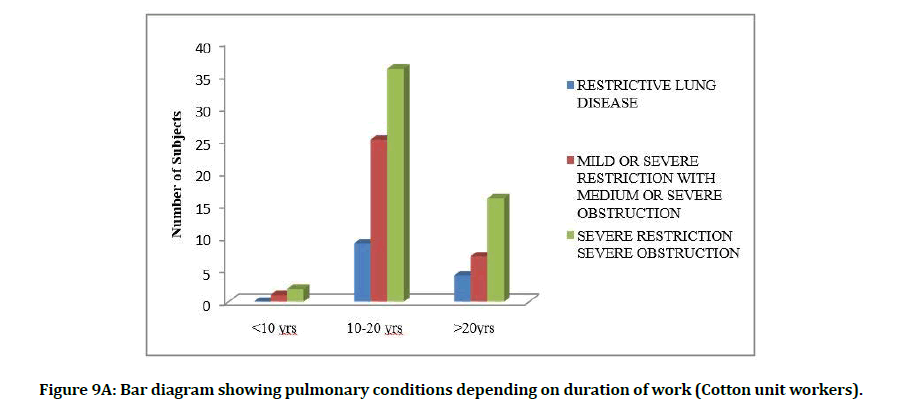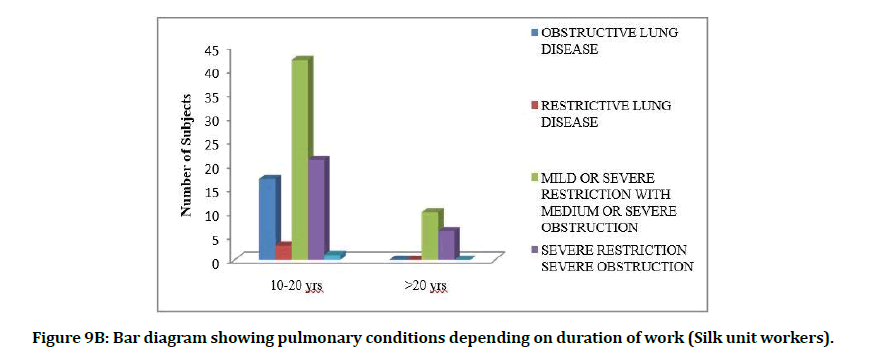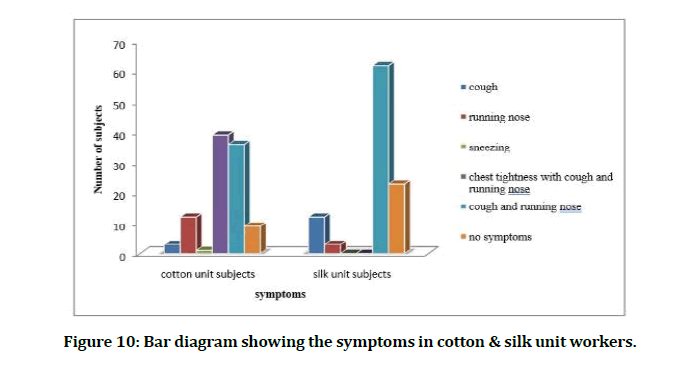Research - (2021) Volume 9, Issue 5
A Study to Assess the Pulmonary Function Among Workers in Silk and Cotton Textile Industry by Spirometry
Anitha, P Saikumar and Renuka Devi MR*
*Correspondence: Renuka Devi MR, Department of Physiology, Sree Balaji Medical College & Hospital Affiliated to Bharath Institute of Higher Education and Research, Chennai, Tamil Nadu, India, Email:
Abstract
The major functions of the ministry of textiles are formulating policy and coordination of manmade fiber, cotton, jute, silk, wool industries, decentralization of power loom sector, promotion of exports and Planning & economic analysis, finance and promoting use of information technology. The Sericulture and Silk Sector: India is the 2nd largest producer of silk in the world. India produces 18% of the world's total silk. Mulberry, Eri, Tasar, and Muga are the main types of silk produced in the country. It is a labor - intensive sector. In our study we also found that the sub section in which people was working as for example spinning, weaving, and twisting, there is a difference in lung function and symptoms. So, the subsection of the working sector also plays a major role. The present is comparing the pulmonary functions of subjects in cotton and silk textile industry with normal subjects and between the workers in the cotton and silk industry. To perform pulmonary function tests in normal people, pulmonary function tests in workers in cotton industry and silk industry.
Keywords
Sericulture, Pulmonary function silk sector, Textiles, Pulmonary function
Introduction
Like any other industries the textile industry has limitations usually called as a regulation that must be met with national and international standards in order to establish quality, safety, sustainability. Government of India passed the National Textile Policy in 2000. The major functions of the ministry of textiles are formulating policy and coordination of man- made fiber, cotton, jute, silk, wool industries, decentralization of power loom sector, promotion of exports and Planning & economic analysis, finance and promoting use of information technology. There are several public sector units and textile research associations across the country. The Sericulture and Silk Sector: India is the 2nd largest producer of silk in the world. India produces 18% of the world's total silk. Mulberry, Eri, Tasar, and Muga are the main types of silk produced in the country. It is a labor - intensive sector.
Silk which is a natural fiber comprised of protein and some forms of protein can be woven into textile. Fibronin is the main constituent in silk produced by larvae to form cocoons of the mulberry silkworm of Bombyx mori. The shimmering appearance of silk is due to the triangular prism-like structure of the silk fiber. Silk which has various name according to the native place they belong such as “Pattuâ?? in south India, “Reshamâ?? in northern and eastern India. Recent investigations of archeological department suggest that silk production and usage in India dates to Indus-valley civilization from native silkworm species. India is the second largest producer of silk in the world after China. About 97% of the raw silk comes from five Indian states, namely, Andhra Pradesh, Karnataka, Jammu and Kashmir, Tamil Nadu, and West Bengal. North Bangalore, the upcoming site of a $20 million "Silk City" Ramanagara and Mysore, contribute to a majority of silk production in Karnataka.
India is the largest consumer of silk in the world, where silk related wearing is considered as royalty, because silk is initially used by upper class personalities. Emerging silk producing districts in Tamilnadu are Salem, Gopichettipalayam, Tiruppur, and Dharmapuri. Mysore and Northern Bangalore are the other states that contribute for most of the silk production [1-15].
Materials and Methods
Study design
This cross-sectional study was carried out in the research lab of Physiology Department of Sree Balaji Medical College and Hospital, Chennai. The study sample was 300 subjects in the age group of 35 -45 years of both sexes, with 100 subjects working in cotton industry, 100 subjects working in silk industry and 100 subjects involved in other occupation. All were belonging to the same socioeconomic status; they were randomly selected. Among the cotton unit workers of 100, 50 were selected from handloom and 50 from powerloom. Within the power loom (50) and handloom sector (50), subjects were selected from spinning and weaving sections each comprising 25 respectively.
Among the power loom sector workers (50) using mask were also selected, based on the details collected through Questionnaire. Workers were categorized into those using mask and not using mask and 25 in each category was selected for the study. The Handloom sector workers (50) of the cotton industry were not using mask, and they were also selected for the study. Among the silk unit workers of 100, 50 were selected from handloom and 50 from power loom. Within the powerloom (50) and handloom (5), subjects were selected from spinning and weaving sections each comprising 25 each. Among the powerloom sector workers (50), of the silk industry, subjects using mask (n=25) and subjects not using mask (n=25) were also selected, based on the details collected through Questionnaire. The Handloom sector workers (50) of the silk industry were not using mask, and they were also selected for the study.
Among the cotton and silk unit workers the duration of their occupation and number of working days per week were also asked and their association with their pulmonary function parameters interpretation was found. Among the cotton and silk unit workers the occupation duration and symptoms were also asked and their association with the pulmonary function parameters interpretation was found.
Distribution of subjects of the study
Inclusion criteria
All Subjects were selected based on the following criteria for the study,
â?? Subjects involved in cotton weaving and spinning.
â?? Subjects involved in silk weaving and spinning and
â?? Normal subjects not exposed to these occupations.
â?? All in the age group of 35 to 45 years of both sexes were selected as subjects for the study.
Exclusion criteria
People with known history of
â?? Smoking.
â?? Alcohol.
â?? Asthma.
â?? Tuberculosis.
â?? Atopy.
â?? COPD.
â?? Any cardiac problems, Diabetes Mellitus, Hypertension.
Also subjects with known contraindications for doing Spirometry according to ATS/ERS protocol were exclude.
Discussion
Sampling procedure
Subjects for the study group were selected randomly in the age group of 35 to 45 years working in the cotton and silk weaving industry and the controls were recruited from a similar socioeconomic status not working in the cotton and silk weaving industry. Subjects were recruited based on inclusion criteria, history, and exclusion criteria.
300 subjects were selected, among them 200 were selected from silk and cotton industry (100 cotton unit workers and 100 silk unit workers) and 100 subjects were not exposed to these cotton and silk industry exposure. Pulmonary function of these subjects was assessed using ATS – ERS accepted KOKO spirometry in the research lab of Physiology Department of Sree Balaji Medical College and Hospital.
Results
Among the total of 200 subjects who represent the cotton and silk exposure workers,
â?? 17 Subjects in silk unit workers had obstructive airway disease.
â?? 16 Subjects, 13 in cotton unit workers and 3 in silk unit workers had restrictive airway disease.
â?? 63 subjects, 17 in cotton and 46 in silk unit had mild restriction, medium obstruction.
â?? 15 subjects, 9 in cotton and 6 in silk unit, had light restriction, severe obstruction.
â?? 7 subjects in cotton unit had severe restriction and medium obstruction.
â?? 81 Subjects, 54 in cotton unit workers and 27 in silk unit workers had severe restriction and severe obstruction.
â?? 1 Subject of silk unit workers has normal pulmonary function parameters.
â?? This clearly shows the exposure to cotton and silk industry plays an important role in the pulmonary functions of the people (Figures 1 to Figure 4).
Figure 1: Bar diagram showing the demographic details of study subjects.
Figure 2: Bar diagram showing the pulmonary function parameters of study subjects.
Figure 3: FEV1/FVC %.
Figure 4: Bar diagram showing comparison of the pulmonary function parameters between the cotton and silk unit subjects.
Figure 5 shows the gender distribution of the study subjects (Males=150 Females=150).
Figure 5: Gender distribution.
Figure 6 shows the difference in pulmonary functions (A & B) of cotton power loom sector subjects between subjects using mask & subjects not using mask. Figure 7 shows the difference in pulmonary functions (a & b) of silk powerloom sector workers between subjects using mask & subjects not using mask.
Figure 6A: Subject using mask and not using mask.
Figure 6B: FEV1/FVC % (Subject using mask and not using mask).
Figure 7A: Bar diagram showing the difference in pulmonary functions (a & b) of silk powerloom sector workers between subjects using mask & subjects not using mask.
Figure 7B: FEV1/FVC % (Subjects using mask and not using mask).
There is an increase in the severe restriction with severe obstruction in subjects in the spinning subsection than weaving subsection of cotton unit workers (Figure 8A). There is an increase in the 1. Restrictive lung disease, 2. Mild or severe restriction with medium or severe obstruction and 3. Severe restriction and severe obstruction in spinning subsection subjects than weaving subsection subjects of silk unit workers. There is an increase in the restriction and mixed and severe airway abnormalities in subjects working more than 10 years but is not statistically significant (Figure 8B). The number of subjects is very less in occupational duration of more than 20 years when compared to a greater number of subjects in 10 to 20 years (Figures 9A and 9B).
Figure 8A: Bar diagram showing pulmonary conditions depending on subsection of exposure in cotton (Cotton unit workers).
Figure 8B: Bar diagram showing pulmonary conditions depending on subsection of exposure in cotton (Silk unit workers).
Figure 9A: Bar diagram showing pulmonary conditions depending on duration of work (Cotton unit workers).
Figure 9B: Bar diagram showing pulmonary conditions depending on duration of work (Silk unit workers).
In cotton unit workers the most common symptoms are Chest tightness on first day of working week, with other symptoms (running nose and cough and wheezing) in 39% subjects, followed by mixed symptoms of running nose and cough other than chest tightness in 36% subjects, followed by running nose in 12% subjects, followed by cough in 3% subjects, followed by sneezing in 1% subjects. 9% subjects have no symptoms (Figure 10).
Figure 10: Bar diagram showing the symptoms in cotton & silk unit workers.
Discussion
In our study the pulmonary functions of subjects working in cotton and silk industry was compared with the subjects not exposed. The pulmonary function was assessed using ATSERS standardized KOKO spirometer.
The pulmonary function was assessed based on two main parameters.
â?? Pulmonary function tests and
â?? Signs and symptoms of respiratory health problem.
And this assessment was done using:
â?? Questionnaire.
â?? Clinical Examination.
Based on this assessment, the pulmonary function interpretation of the study population observed were,
I. Subjects having normal lung function.
II. Subjects with Obstructive lung disease.
III. Subjects with Restrictive lung disease.
â?? Subjects having mixed airway disease including both obstructive lung disease and restrictive lung disease which further includes,
â?? Subjects with mild restriction, medium obstruction.
â?? Subjects with mild restriction, severe obstruction.
â?? Subjects with severe restriction and medium obstruction and
â?? Subjects with severe restriction and severe obstruction.
From the results of our study, it is clearly evident that,
â?? Subjects had a decrease in lung functions, in both subjects working in cotton and silk industry when compared with normal subjects not exposed to these working environments.
â?? Also the decrease in lung function of cotton unit workers are more than silk unit workers, as seen by more number of Obstructive lung disease in silk unit subjects and more number of Restrictive lung disease in cotton unit subjects.
â?? There is a decrease in pulmonary function parameters in the females when compared to males.
â?? Subjects who were working in the Handloom sector, had a better lung function than subjects who were working in the Powerloom sector of the silk unit.
â?? Subjects who were working in the Powerloom sector, using mask had a better lung function than subjects who were not using the mask working in the same env ironmental conditions of cotton and silk unit workers.
â?? Also the symptoms and the frequency of the subjects falling sick were less in the mask using subjects than compared with the subjects not using mask.
â?? This shows a clear drift in the lung functions of subjects using mask in both the cotton and silk unit workers.
â?? The pulmonary function decreases if the duration of occupation increases more than 10 years.
â?? And we also observed most of the impairment in lung function obviously were associated with respiratory symptoms.
â?? There are few studies recommending the use of mask as a protective factor but have not established the fact. In our study we tried to establish the effectiveness of mask as a protective factor.
Pulmonary function parameters of cotton and silk unit subjects
FEV1, PEF, MEF
In many of the previous studies there was a decrease in FEV1. There was a decrease in FVC of the cotton unit subjects when compared with control subjects. There was a decrease in FEV1, PEFR, MEF 25-75 in cotton unit workers. An observation done to assess PEFR and MEF 75 are less in cotton textile workers indicating bronchi are affected by cotton dust expos ed subjects. The histamine released from the mast cells due to cotton dust inhalation leads to Broncho constriction by 1. Acting on the smooth muscles, 2. Stimulating the vagus nerve which in turn causes smooth muscle contraction and 3. activating the mucus glands of the airway to secrete more mucus. So as result of smooth muscle contraction, and increased secretion, there is constriction of airways which leads to reduced air entry [22]. In our study we found that there is a significant decrease in FVC, FEV1, PEF, MEF 35, 35, 25, 35, in subjects working in cotton unit. In our study among silk unit subjects, FVC, FEV1, FEV1/FVC were decreased significantly when compared with the control subjects and PEF, MEF in the silk unit workers decreased than the control subjects. The cotton group larger cross-shift decrements in FEV than the silk group. There was an increased decline in FVC and FEV1 of cotton workers than silk workers, was observed in a previous study done in cotton and silk unit workers. In our study FVC, FEV1, PEF, and MEF 75 decreased significantly (0.00) in the cotton unit subjects than the silk unit subjects. From our study we observed, MEF 50, MEF 25, MEF 25-75 of the silk unit workers decreased significantly when compared to the cotton unit workers. The decrease in lung function from our study for the subjects working in cotton and silk unit when compared with control groups suggest that lung function impairment due to textile dust plays a vital role in the health of the workers involved in that industry [16-27].
Conclusion
The pulmonary parameters are decreased significantly in the subjects working in cotton and silk industry compared to the normal subjects. The pulmonary parameters are decreased significantly in the subjects working in cotton industry when compared to subjects working in silk industry. There is decrease in the pulmonary parameters of females when compared to males. The subjects working in handloom sector have better lung function than the powerloom sector in silk unit. The subjects using mask have better pulmonary function when compared to the subjects not using mask in cotton and silk unit. The subjects working in weaving subsection have a smaller number of severe airway disease when compared to the subjects working in spinning subsection in cotton and silk unit. The pulmonary function parameters decrease when duration of occupation is more than 10 years in both cotton and silk unit workers. The pulmonary function decreases when there is a decreased (1 or nil) break off in cotton and silk unit workers when compared with pulmonary function of subject’s people having 2 days break off. There is a significant association between the symptoms and decreased pulmonary function interpretation parameters. There is a heavy competition for the Handloom sector from the Powerloom sector. The Handloom wages are less paid by the Government and owners. So in the upcoming years, the diminishing of the handloom should be properly assessed. If proper steps are not taken it may become diminished in the next 10 years. The responsibility for improving the health and safety conditions of garment workers lies with the government and nongovernmental agencies as well as the employers. Exhaust systems should be provided for textile workers which ensure proper ventilation and regular supply of fresh air in group workspaces. Use of personnel protective equipment’s (PPE) like masks or respirators with mechanical filters or with oxygen or air supply, ear plugs, earmuffs should be made mandatory. This finding throws a light on the fact that using mask has a significant contribution in the proper functioning of lung health, by decreasing the quantity of exposure to these occupational cotton and silk dust, thereby reducing the dust entry into the lungs, helping as a protecting agent for lungs and thereby contributing to the nation by improvement of the quality of life of the textile sector workers.
Funding
No funding sources.
Ethical Approval
The study was approved by the Institutional Ethics Committee.
Conflict of Interest
The authors declare no conflict of interest.
Acknowledgements
The encouragement and support from Bharath University, Chennai is gratefully acknowledged. For provided the laboratory facilities to carry out the research work.
References
- Ahmad N, Goel R, Hasan N. A study of FEV1/FVC ratio in loom workers of meerut city. National J Physiol Pharmacy Pharmacol .2013; 3:176–178.
- https://archive.epa.gov/compliance/resources/publications/assistance/sectors/web/pdf/textilsn.pdf
- http://texmin.nic.in/sites/default/files/jutepolicy2005.pdf
- https://openlibrary.org/books/OL5315331M/A_handbook_of_textiles
- Mohanty GF. Labor and laborers of the loom: Mechanization and handloom weavers. CRC Press 2006; 1780-1840.
- https://www.fibre2fashion.com/industry-article/?page=1
- https://www.yumpu.com/en/document/view/49322044/may-2013-citi-confederation-of-indian-textile-industry
- https://www.fibre2fashion.com/industry-article/543/indian-textile-industry
- https://www.kearney.com/
- Nag A, Vyas H, Nag PK. Gender differences, work stressors and musculoskeletal disorders in weaving industries. Industrial Health 2010; 48:339-348.
- Bajpai DN, Shukla PN. Growth of sericulture and its impact on silk textile industry in Uttar Pradesh. Works of the Catalan Geographical Society 1985:23-42.
- Wang XR, Pan LD, Zhang HX. Follow-up study of respiratory health of newly-hired female cotton textile workers. Am J Ind Med 2002; 41:111–18.
- https://www.iloencyclopaedia.org/part-xiv-42166/textile-goods-industry/item/891-respiratory-effects-and-other-disease-patterns-in-the-textile-industry#:~:text=Respiratory%20Effects%20and%20other%20Disease%20Patterns%20in%20the%20Textile%20Industry,-Written%20by%20ILO&text=For%20nearly%20300%20years%2C%20work,who%20card%20flax%20and%20hemp.
- Encyclopedia of occupational health and safety. Geneva: International Labour Organization; 2011.
- https://anthropologicalstudy.blogspot.com/2011/03/health-status-of-textile-industrial.html?m=0
- Niven RM, Fletcher AM, Picjering CAC. Chronic bronchitis in textile workers. Thorax 1997; 52:22 –27.
- Fox AJ, Tombleson JBL, Watt A. A survey of respiratory disease in cotton operatives. Part 2. Symptoms, dust estimation and the effect of smoking habit. Br J Ind Med 1973; 30:48–53.
- Beck GJ, Schacter EN, Maunder LR. The relationship of respiratory symptoms and lung function loss in cotto n textile workers. Am Rev Respir Dis 1984; 43:580–586.
- Merchant JA, Kilburn KH, O’Fallon WM, et al. Byssinosis and chronic bronchitis among cotton textile workers. Ann Intern Med 1972; 76:423 -433.
- Parikh JR, Bhangia LJ, Majumdar PK, et al. Prevalence of byssinosis in textile mills at Ahmedabad, India. Br J Ind Med 1989; 46:787-790.
- Jiang CQ, Lam TH, Kong C. Byssinosis in Guangzhou, China. Occup Environ Med 1995; 52:268–272.
- Zuskin E, Ivankovic D, Schachter EN. A ten-year follow-up study of cotton textile workers. Am Rev Respir Dis 1991; 143:301–305.
- Schilling RSF. Yale Epidemiological studies of chronic respiratory disease among cotton operatives. J Biol Med 1964; 37:55–74.
- Raza SN, Fletcher AM, Pickering CA. Respiratory symptoms in Lancashire textile weavers. Occup Environ Med 1999; 56:514–519.
- Molyneux MKB, Tombleson JBL. An epidemiological study of respiratory symptoms in Lancashire mills, 1963 –1966. Br J Ind Med 1970; 27:225–234.
- Wang XR, Christiani DC. Respiratory symptoms and functional status in workers exposed to silica, asbestos, and coal mine dusts. J Occup Environ Med. 2000; 42:1076–1084.
- Shi NY, Lu PL. Pulmonary function study of retired cotton textile workers and the relationship to cigarette smoking. Biomed Environ Sci 1988; 1:152–159.
Author Info
Anitha, P Saikumar and Renuka Devi MR*
Department of Physiology, Sree Balaji Medical College & Hospital Affiliated to Bharath Institute of Higher Education and Research, Chennai, Tamil Nadu, IndiaReceived: 20-Mar-2021 Accepted: 11-May-2021 Published: 18-May-2021

